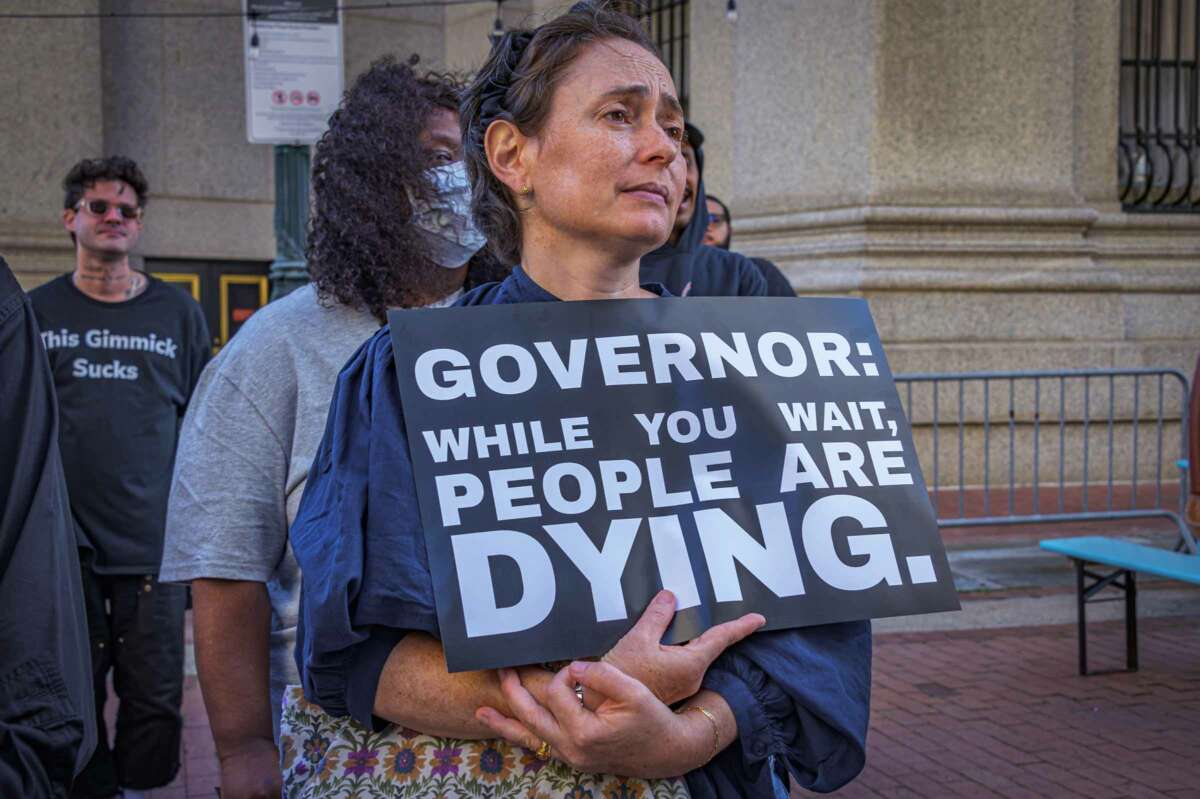Part of the Series
The Road to Abolition
Honest, paywall-free news is rare. Please support our boldly independent journalism with a donation of any size.
So far in 2023, three people incarcerated on drug offenses — Dustin Montanez, Patrick Miller and Giles Gerhart — have died in the Onondaga County Justice Center, a jail located in Syracuse, New York. Syracuse is the county seat of Onondaga County, which has maintained an incarcerated population of approximately 500 people.
Forty-year-old Montanez was first arrested in 2015 for third-degree criminal possession of a controlled substance and second-degree burglary. He was placed on parole in 2017 after serving two years in the Groveland Correctional Facility. Once on parole, he would have to report to a parole officer, submit to drug tests and random home visits, and pay monthly supervision fees. He was booked into the Syracuse jail after a parole violation, and was found unconscious in his cell on March 4. The New York State Attorney General’s Office of Special Investigation labeled his death a suicide, adding to the staggering rate of jail suicide deaths.
Forty-three-year-old Miller died a month later, on April 5. He was arrested on a warrant for two petit larcenies and seventh-degree criminal possession of a controlled substance. After two days, he was found unresponsive in his cell. Nurses attempted to revive him and pronounced him dead after 40 minutes. Onondaga County Sheriff’s Spokesman Tom Newton relayed to reporters that Miller “had a history of an untreated medical condition” and “a history of narcotics use.” He had been participating in a drug treatment program and was detoxing at the time of his death.
Similarly, 39-year-old Gerhart died on September 6. He was arrested on warrants for four misdemeanors, including possession of a controlled substance, trespass and assault. Gerhart was found unresponsive in his cell after having told staff that “he was addicted to heroin and fentanyl,” according to Onondaga County Sheriff Toby Shelley. Miller and Gerhart’s deaths add to the equally staggering rate of jail detox deaths.
Despite such cases, reporters and legislators have maintained faith in “carceral treatment” as a tactic to fight the opioid crisis. Indeed in 2021, two years prior to Miller and Gerhart’s deaths, New York Gov. Kathy Hochul signed a bill into law that mandates medication-assisted treatment and clinical/peer support services in New York State’s jails and prisons. Such services would, she assured, allow incarcerated individuals to “have the opportunity to treat their addiction and return to healthy and productive lives.”
Montanez, Miller and Gerhart never returned to their lives. Their deaths represent what sociologist and social worker Reuben Jonathan Miller refers to as the “afterlife of incarceration,” as their families are left to memorialize them in obituaries, writing of their smiles, laughs and lovable personalities.
Rather than providing adequate health care, jails and prisons confine, punish and control. Indeed, New York Focus reported that those incarcerated in nearby Broome County Sheriff’s Corrections Division are being made to wait for medication-assisted treatment services, often receive inadequate dosages, and are sometimes switched from methadone to Subutex (buprenorphine) once behind bars. Incarcerated in Broome County, Keith Keefer was taken off methadone and was waiting for program access, telling New York Focus, “I’m like a potential overdose waiting to happen.”
It is imperative people receive resources both inside and outside of jails and prisons. Small improvements in carceral care can be made by counties when they hire their own medical staff or contract with local nonprofit health care providers instead of for-profit providers, Andrew Pragacz of Justice and Unity for the Southern Tier notes. Indeed, Onondaga and Broome County both contract with private providers, Wellpath Care and PrimeCare Medical, respectively. Regardless of provider status, community oversight and accountability are a must.
Still, even if New York’s medication-assisted treatment program is improved by increasing medication dosage or removing for-profit providers, it’s still no solution to the state’s opioid crisis. Disinvesting in so-called “carceral solutions” and investing in community-based care — including harm reduction, treatment and health care support disentangled from the criminal punishment system — is key to addressing drug-related harms, as well as the myriad of harms produced by the criminal punishment system.
Abolitionists Kelly Hayes and Mariame Kaba highlight the importance of mutual aid as “Collective and community-based practices and efforts to meet people’s needs, independent of state systems and other hierarchical, oppressive arrangements.” Transformative justice, too, remedies harms in ways that restore and connect. After all, these men were arrested for offenses beyond drug possession, many of which are similarly not well-addressed in a system that merely stigmatizes and dehumanizes.
The ongoing reliance on incarceration as a “solution” to the opioid crisis is misguided and dangerous. Simply put, jails and prisons are still not the answer to the opioid crisis when, all too often, a drug arrest becomes a death sentence.
Press freedom is under attack
As Trump cracks down on political speech, independent media is increasingly necessary.
Truthout produces reporting you won’t see in the mainstream: journalism from the frontlines of global conflict, interviews with grassroots movement leaders, high-quality legal analysis and more.
Our work is possible thanks to reader support. Help Truthout catalyze change and social justice — make a tax-deductible monthly or one-time donation today.
